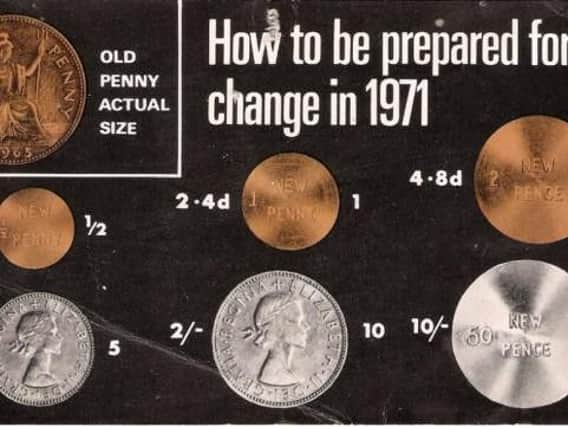ON THIS DAY: 1971: Doncaster and Britain goes decimal


The ‘D-Day’ referred to here is not the Normandy Landings of June 6, 1944 when Allied Forces began on the road to finally winning World War II, but to February 15, 1971 when currency in both Britain and Ireland switched from the old Imperial monetary system.
Decimal Day in fact had been a very long time in arriving. Under the old currency of pounds, shillings and pence, the pound was made up of 240 pence denoted by the letter ‘d’ for Latin denarius, with 12 in the shilling and 20 shillings in a pound.
Advertisement
Hide AdAdvertisement
Hide AdYet, as far back as 1862, the Westminster Select Committee on Weights and Measures favoured the introduction of decimalisation to accompany the introduction of metric weights and measures. The Royal Commission on Decimal Coinage (1918-20) also examined various ways of achieving decimalisation, but again no agreement on a new system was reached.
In 1960 a report prepared by the British Association for the Advancement of Science and the Association of British Chambers of Commerce, buoyed by the success of decimalisation in South Africa, prompted the British Government to set up of the Inquiry on Decimal Currency.
The inquiry reported back in 1963 and the changes suggested were announced another three years later in 1966. Following this the Decimal Currency Board (DCB) was created to manage to transition, although the plans were not formally approved by Parliament until the Decimal Currency Act of May, 1969.
Under the new system, the pound was divided into 100 new pence, denoted by the symbol ‘p’.
Advertisement
Hide AdAdvertisement
Hide AdNew coinage was issued alongside the old coinage. The new 5p and 10p coins were introduced in 1968 and were the same size, composition and value as the shilling and two shilling coins in circulation with them. In October, 1969, the 50p coin was introduced, with the 10 shilling note withdrawn on November, 20, 1970. This reduced the number of coins that had to be introduced on Decimal Day and meant the public already knew three of the six new coins. Advice booklets were made available on all the new denominations.
There was a substantial publicity campaign in the weeks before Decimalisation Day, including a song by Max Bygraves called “Decimalisation”. The BBC ran a series of five-minute programmes called ‘Decimal Five’ and ITV repeatedly broadcast a short drama called ‘Granny Gets the Point’, starring Doris Hare, the actress in On The Buses, where an elderly woman does not understand the new system is taught to use the new system by her grandson.
Banks received stocks of the new coins in advance and these were issued to retailers shortly before ‘D-Day’ to enable them to give change immediately after the switch over. Banks closed from 3.30pm on Wednesday February 10, 1971 until 10am on Monday 15 to allow all outstanding cheque and credits in the balance system to be processed and for customer accounts to be converted. This process was done manually as most bank branches were not as yet computerised.
February was chosen for the launch because it was the quietest time of the year for the banks, shops and transport organisations.